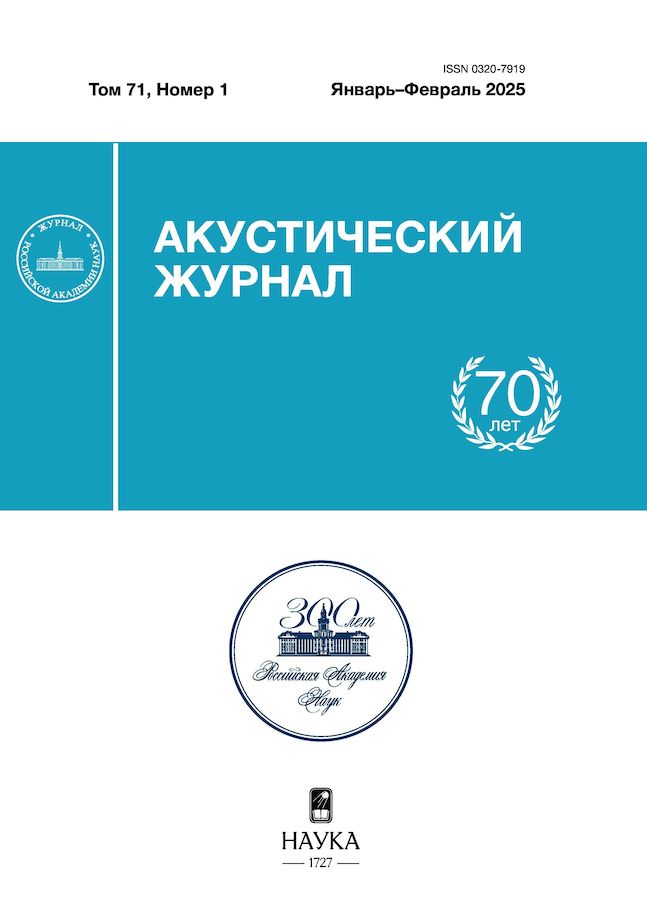Estimation of the coefficient of sound reflection from the bottom based on the analysis of the spatio-angular field structure
- Authors: Virovlyansky A.L.1, Kazarova A.Y.1
-
Affiliations:
- A.V. Gaponov-Grekhov Institute of Applied Physics of the Russian Academy of Sciences
- Issue: Vol 71, No 1 (2025)
- Pages: 88-95
- Section: АКУСТИКА ОКЕАНА. ГИДРОАКУСТИКА
- URL: https://bulletin.ssaa.ru/0320-7919/article/view/683641
- DOI: https://doi.org/10.31857/S0320791925010109
- EDN: https://elibrary.ru/BQIDYV
- ID: 683641
Cite item
Abstract
A method for estimating the coefficient of sound reflection from the bottom of a waveguide based on field measurements using a vertical array at various distances from the source is discussed. To analyze the spatial-angular structure of the recorded field, the method of coherent states, borrowed from quantum theory, is used. The acoustic analogue of the coherent state expansion allows one to construct a filter to isolate the field component representing the contribution of a given narrow beam of rays. The ratio of the amplitudes of such a field component before and after reflection from the ground gives an estimate of the reflection coefficient of the central ray. The effectiveness of the approach was tested using numerical simulation data. The results of its application for processing data from a lake experiment are presented.
Full Text
About the authors
A. L. Virovlyansky
A.V. Gaponov-Grekhov Institute of Applied Physics of the Russian Academy of Sciences
Author for correspondence.
Email: viro@ipfran.ru
Russian Federation, Ulyanova 46, Nizhny Novgorod, 603950
A. Yu. Kazarova
A.V. Gaponov-Grekhov Institute of Applied Physics of the Russian Academy of Sciences
Email: viro@ipfran.ru
Russian Federation, Ulyanova 46, Nizhny Novgorod, 603950
References
- Wang Z., Ma Y., Kan G., Liu B., Zhou X., Zhang X. An inversion method for geoacoustic parameters in shallow water based on bottom reflection signal // Remote Sens. 2023. V. 15(13). P. 3237.
- Chapman N.R. Perspectives on geoacoustic inversion of ocean bottom reflectivity data // J. Mar. Sci. Eng. 2016. V. 4(3). P. 61.
- Dong H., Chapman N.R. Measurement of ocean bottom reflection loss with a horizontal line array // Acta Acust. 2016. V. 102. N. 4. P. 645–651.
- Schmidt H., Jensen F.B. Evaluation of experimental techniques for determining the plane wave reflection coefficient at the seafloor // In Ocean Seismo-Acoustics. Eds. Akal T., Berkson J.M. N. Y.: Plenum, 1986. P. 721–730.
- Носов А.В., Постнов Г.А. Измерение акустических параметров дна океана с помощью многократно рассеянных звуковых импульсов // Акуст. журн. 2001. Т. 47. № 4. С. 520–524.
- Klauder J.R., Sudarshan E.C.G. Fundamentals of quantum optics. N.Y.: W.A. Benjamin, 1968. 304 p. Сударшан Э., Клаудер Дж. Основы квантовой оптики. М.: Мир, 1970. 430 с.
- Шляйх В.П. Квантовая оптика в фазовом пространстве. М.: Физматлит, 2005. 760 с.
- Вировлянский А.Л., Казарова А.Ю. Распределение интенсивности звукового поля в глубоком море в фазовом пространстве “глубина–угол–время”// Акуст. журн. 2023. Т. 69. № 5. С. 515–527.
- Virovlyansky A.L., Kazarova A.Yu., Lyubavin L.Ya. Matched field processing in phase space // J. Ocean Eng. 2020. V. 45. N. 4. P. 1583–1593.
- Вировлянский А.Л. Выделение компоненты поля, формируемой заданным пучком лучей на апертуре приемной антенны в неоднородной среде // Успехи физ. наук. 2023. Т. 193. № 9. С. 1010–1020.
- Ландау Л.Д., Лифшиц Е.М. Квантовая механика. Нерелятивистская теория. М.: Наука, 1973. 752 с.
- Макаров Д.В. Об измерении углов прихода акустических импульсов с помощью вертикальной антенны // Акуст. журн. 2017. Т. 63. № 6. С. 637–645.
- Makarov D.V., Kon’kov L.E. Angular spectrum of acoustic pulses at long ranges // J. Mar. Sci. Eng. 2023. V. 11(1). P. 29.
- Porter M.B. The KRAKEN Normal Mode Program; Technical Report (La Spezia: SACLANT Undersea Research Centre), 1991.
- Бреховских Л.М., Лысанов Ю.П. Теоретические основы акустики океана. М.: Наука, 2007. 370 с.
- Jensen F.B., Kuperman W.A., Porter M.B., Schmidt H. Computational Ocean Acoustics. New York: Springer, 2011.
Supplementary files

















